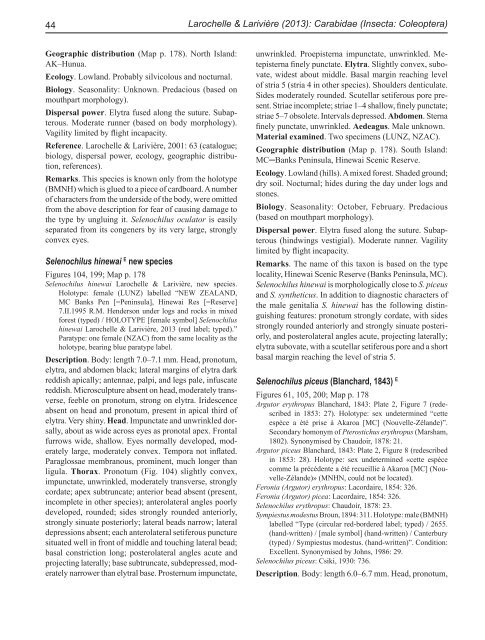Fauna of New Zealand 69 - Landcare Research
Fauna of New Zealand 69 - Landcare Research
Fauna of New Zealand 69 - Landcare Research
You also want an ePaper? Increase the reach of your titles
YUMPU automatically turns print PDFs into web optimized ePapers that Google loves.
44<br />
Geographic distribution (Map p. 178). North Island:<br />
AK–Hunua.<br />
Ecology. Lowland. Probably silvicolous and nocturnal.<br />
Biology. Seasonality: Unknown. Predacious (based on<br />
mouthpart morphology).<br />
Dispersal power. Elytra fused along the suture. Subapterous.<br />
Moderate runner (based on body morphology).<br />
Vagility limited by flight incapacity.<br />
Reference. Larochelle & Larivière, 2001: 63 (catalogue;<br />
biology, dispersal power, ecology, geographic distribution,<br />
references).<br />
Remarks. This species is known only from the holotype<br />
(BMNH) which is glued to a piece <strong>of</strong> cardboard. A number<br />
<strong>of</strong> characters from the underside <strong>of</strong> the body, were omitted<br />
from the above description for fear <strong>of</strong> causing damage to<br />
the type by ungluing it. Selenochilus oculator is easily<br />
separated from its congeners by its very large, strongly<br />
convex eyes.<br />
Selenochilus hinewai E new species<br />
Figures 104, 199; Map p. 178<br />
Selenochilus hinewai Larochelle & Larivière, new species.<br />
Holotype: female (LUNZ) labelled “NEW ZEALAND,<br />
MC Banks Pen [=Peninsula], Hinewai Res [=Reserve]<br />
7.II.1995 R.M. Henderson under logs and rocks in mixed<br />
forest (typed) / HOLOTYPE [female symbol] Selenochilus<br />
hinewai Larochelle & Larivière, 2013 (red label; typed).”<br />
Paratype: one female (NZAC) from the same locality as the<br />
holotype, bearing blue paratype label.<br />
Description. Body: length 7.0–7.1 mm. Head, pronotum,<br />
elytra, and abdomen black; lateral margins <strong>of</strong> elytra dark<br />
reddish apically; antennae, palpi, and legs pale, infuscate<br />
reddish. Microsculpture absent on head, moderately transverse,<br />
feeble on pronotum, strong on elytra. Iridescence<br />
absent on head and pronotum, present in apical third <strong>of</strong><br />
elytra. Very shiny. Head. Impunctate and unwrinkled dorsally,<br />
about as wide across eyes as pronotal apex. Frontal<br />
furrows wide, shallow. Eyes normally developed, moderately<br />
large, moderately convex. Tempora not inflated.<br />
Paraglossae membranous, prominent, much longer than<br />
ligula. Thorax. Pronotum (Fig. 104) slightly convex,<br />
impunctate, unwrinkled, moderately transverse, strongly<br />
cordate; apex subtruncate; anterior bead absent (present,<br />
incomplete in other species); anterolateral angles poorly<br />
developed, rounded; sides strongly rounded anteriorly,<br />
strongly sinuate posteriorly; lateral beads narrow; lateral<br />
depressions absent; each anterolateral setiferous puncture<br />
situated well in front <strong>of</strong> middle and touching lateral bead;<br />
basal constriction long; posterolateral angles acute and<br />
projecting laterally; base subtruncate, subdepressed, moderately<br />
narrower than elytral base. Prosternum impunctate,<br />
Larochelle & Larivière (2013): Carabidae (Insecta: Coleoptera)<br />
unwrinkled. Proepisterna impunctate, unwrinkled. Metepisterna<br />
finely punctate. Elytra. Slightly convex, subovate,<br />
widest about middle. Basal margin reaching level<br />
<strong>of</strong> stria 5 (stria 4 in other species). Shoulders denticulate.<br />
Sides moderately rounded. Scutellar setiferous pore present.<br />
Striae incomplete; striae 1–4 shallow, finely punctate;<br />
striae 5–7 obsolete. Intervals depressed. Abdomen. Sterna<br />
finely punctate, unwrinkled. Aedeagus. Male unknown.<br />
Material examined. Two specimens (LUNZ, NZAC).<br />
Geographic distribution (Map p. 178). South Island:<br />
MC─Banks Peninsula, Hinewai Scenic Reserve.<br />
Ecology. Lowland (hills). A mixed forest. Shaded ground;<br />
dry soil. Nocturnal; hides during the day under logs and<br />
stones.<br />
Biology. Seasonality: October, February. Predacious<br />
(based on mouthpart morphology).<br />
Dispersal power. Elytra fused along the suture. Subapterous<br />
(hindwings vestigial). Moderate runner. Vagility<br />
limited by flight incapacity.<br />
Remarks. The name <strong>of</strong> this taxon is based on the type<br />
locality, Hinewai Scenic Reserve (Banks Peninsula, MC).<br />
Selenochilus hinewai is morphologically close to S. piceus<br />
and S. syntheticus. In addition to diagnostic characters <strong>of</strong><br />
the male genitalia S. hinewai has the following distinguishing<br />
features: pronotum strongly cordate, with sides<br />
strongly rounded anteriorly and strongly sinuate posteriorly,<br />
and posterolateral angles acute, projecting laterally;<br />
elytra subovate, with a scutellar setiferous pore and a short<br />
basal margin reaching the level <strong>of</strong> stria 5.<br />
Selenochilus piceus (Blanchard, 1843) E<br />
Figures 61, 105, 200; Map p. 178<br />
Argutor erythropus Blanchard, 1843: Plate 2, Figure 7 (redescribed<br />
in 1853: 27). Holotype: sex undetermined “cette<br />
espèce a été prise à Akaroa [MC] (Nouvelle-Zélande)”.<br />
Secondary homonym <strong>of</strong> Pterostichus erythropus (Marsham,<br />
1802). Synonymised by Chaudoir, 1878: 21.<br />
Argutor piceus Blanchard, 1843: Plate 2, Figure 8 (redescribed<br />
in 1853: 28). Holotype: sex undetermined «cette espèce<br />
comme la précédente a été recueillie à Akaroa [MC] (Nouvelle-Zélande)»<br />
(MNHN, could not be located).<br />
Feronia (Argutor) erythropus: Lacordaire, 1854: 326.<br />
Feronia (Argutor) picea: Lacordaire, 1854: 326.<br />
Selenochilus erythropus: Chaudoir, 1878: 23.<br />
Sympiestus modestus Broun, 1894: 311. Holotype: male (BMNH)<br />
labelled “Type (circular red-bordered label; typed) / 2655.<br />
(hand-written) / [male symbol] (hand-written) / Canterbury<br />
(typed) / Sympiestus modestus. (hand-written)”. Condition:<br />
Excellent. Synonymised by Johns, 1986: 29.<br />
Selenochilus piceus: Csiki, 1930: 736.<br />
Description. Body: length 6.0–6.7 mm. Head, pronotum,
















